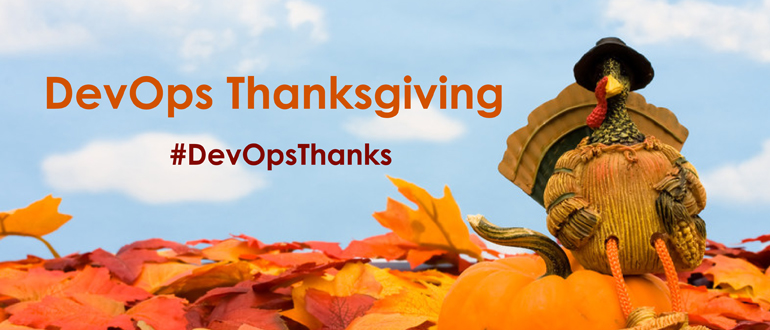As we head into Thanksgiving and the start of holiday season here in the U.S., I wanted to reach out to readers, visitors and friends around the world with a message: In spite of things that make us all sad, there is much to be thankful for this year.
Hopefully, you are not living in an active war zone. Living in peace is something we used to take for granted. It is hard to concentrate on developing code and things like CI/CD, observability and vulnerabilities when you are worried about bombs, drones and gunshots around you. I never used to feel grateful for living a life that allowed me to focus on my work, building a better company and doing more business. But I realize this year how thankful I am to be able to pursue my livelihood in peace. While news of war, death and destruction is never far from our ears, it seems, for most of us, our ears and eyes are as close as it gets. For this, let us be thankful.
While this past year has seen so many layoffs and cutbacks, especially in the tech industry, we should be thankful for earning our livelihoods in an industry that is still so dynamic. We work in an industry that continues to lead the world with bold new innovations and cutting-edge technologies. Even for our friends who were impacted by the cutbacks and layoffs, most have found new jobs and greater opportunities to explore and grow. The past few years have seen such huge growth that some contraction, I guess, is to be expected. But overall, the tech industry is still chugging along. For this, let us be thankful.
What about DevOps, you ask? Well, let us be thankful for DevOps, which continues to evolve and adapt to the opportunities in the market. With innovations in platform engineering, cloud-native technology, GitOps and more, DevOps has proven resilient and adaptable in absorbing these innovations to continue allowing us to develop faster, better, higher-quality code. I am excited about some of the AI-powered innovations that seem on the cusp of once again accelerating our development and deployment choices. This coming year, I believe DevOps will continue to be a major force in IT departments. For this, let us be thankful.
Another trend I have watched develop this year is a return to a semblance of normalcy. We emerged from the pandemic and are returning to offices (well, some of us, anyway). We are going to in-person events and even dusting off our business wear. I think some of the traditional IT frameworks, like ITSM, project management, etc., will freshen up as they combine with new trends like generative AI, DevOps and more. This should bring a new spark to some of the more mature areas of IT and will revitalize IT across the board. For this, let us be thankful.
Finally, let us be thankful that you are reading this in good health. There are many biotech breakthroughs on the horizon that can make our lives so much better. This past year, I have personally undergone my own technology-powered transformation and am healthier and fitter than I have been in a long time. I hope you take time this holiday season to concentrate on your own personal wellness and physical condition. A life well lived requires you to live well. There are so many options available to help you. For this, let us be thankful.
From all of us here at Techstrong Group to all of our friends around the world, happy Thanksgiving and best wishes for this holiday season.
Filed Under: Blogs, Business of DevOps, DevOps 101, DevOps Culture, DevOps Onramp, Features, Leadership Suite, News, Social – Facebook, Social – LinkedIn, Social – X Tagged With: careers, CI/CD, devops, thanksgiving
Secure Coding Practices
Step 1 of 7
14%
Does your organization currently implement secure guardrails in the software development process?(Required)
Yes, extensively across all projects
Yes, but only in specific projects or teams
In the process of implementation
No, but planning to in the near future
No, and no plans to implement
What are the biggest challenges you face in implementing secure guardrails within your development processes? (Select all that apply)(Required)
Lack of awareness or understanding
Technical difficulties in integration
Resistance from development teams
Lack of suitable tools
Cost constraints
Other
Other, tell us more:
How effective do you find secure guardrails in preventing security vulnerabilities in your projects? Rate on a scale from 1 (Not effective) to 5 (Highly effective)(Required)
1
2
3
4
5
To what extent are your secure guardrails automated?(Required)
Fully automated
Mostly automated with some manual processes
Equally automated and manual
Mostly manual with some automation
Entirely manual
What features do you prioritize in a secure guardrail solution? (Rank in order of importance)Ease of integration into existing workflowsComprehensive coverage of security vulnerabilitiesCustomizability for specific project needsMinimal impact on development speedActionable insights and recommendationsSupport for a wide range of programming languages and frameworks
What are your organization’s plans regarding the adoption or enhancement of secure guardrails within the next 12 months?(Required)
Expand the use of secure guardrails to more projects
Enhance the capabilities of existing secure guardrails
Maintain current level of secure guardrail use without changes
Reduce reliance on secure guardrails
No plans related to secure guardrails
What best describes your primary role?(Required)
Security Engineer
DevOps Engineer
Platform Engineer
Security champion on the development team
Software Developer
CISO (or equivalent)
Sr. Management (CEO, CTO, CIO, CPO, VP)
Manager, Director
Other
Δ
